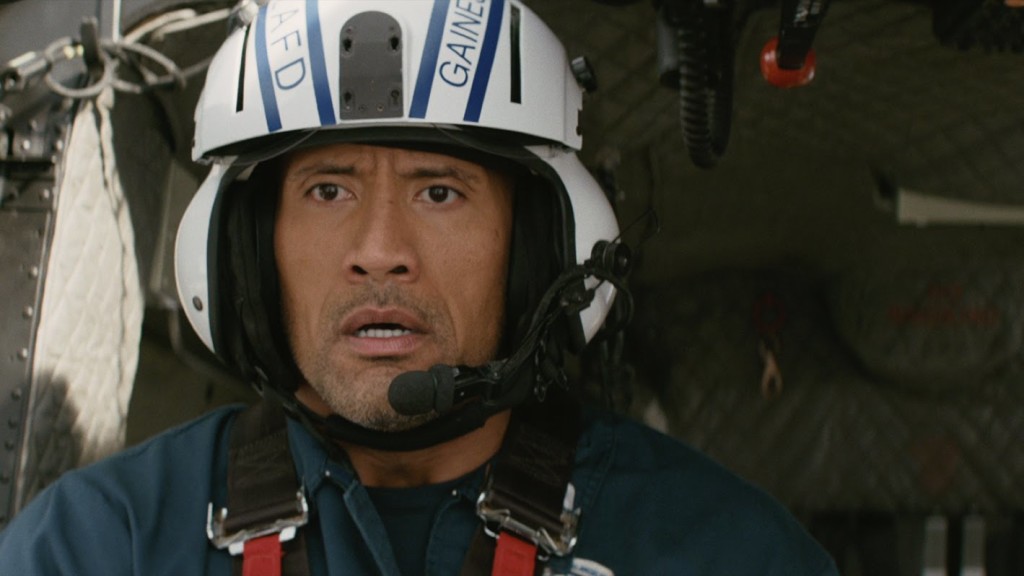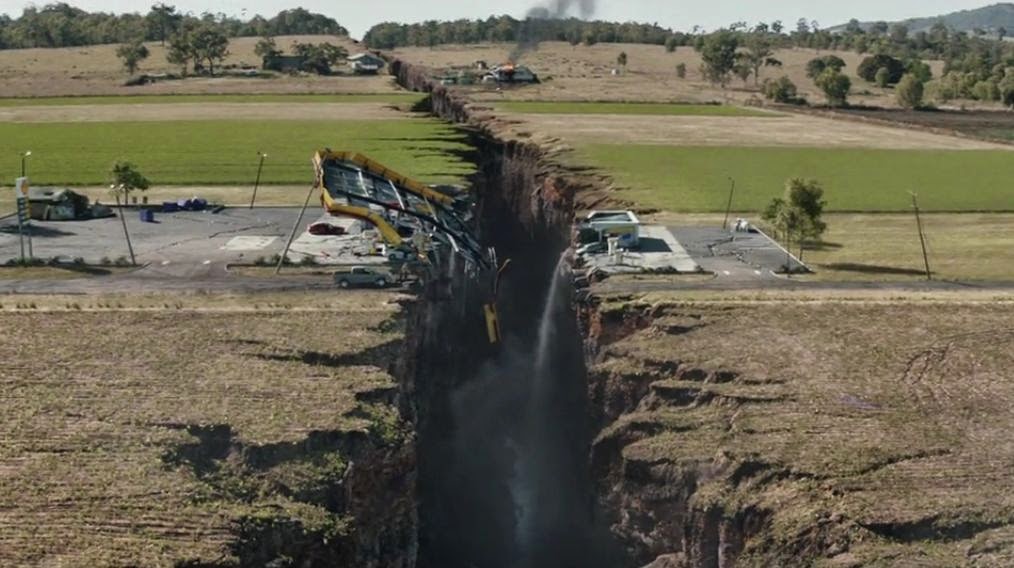How many writers does it take to write one disaster pic? A lot more than you think!
Genre: Action
Premise: After a massive earthquake hits the West Coast, a rescue-chopper pilot travels across the wasteland to save his daughter.
About: San Andreas came out this weekend and bested predictions with 50 million big ones (a good 10 million higher than most estimates). I guess you could say it was an AFTER-shock to analysts. Get it? Cause aftershocks are earthquakes? The film stars the most likable movie star in the business, The Rock, and was directed by The Rock collaborator, Brad Peyton, who worked with the muscled one on Journey to the Center of the Earth 2. While Andre Fabrizio and Jeremy Passmore wrote this draft, it looks like Carlton Cuse (of Lost fame) received final credit, with Fabrizio and Passmore having to settle for story credit.
Writers: Andre Fabrizio & Jeremy Passmore, revisions by Allan Loeb (10/26/11), Revisions by Carlton Cuse (11/02/12), Current Revisions by The Hayes Brothers 7/24/2013
Details: 108 pages
Reading the title page of San Andreas is a bit like reading a screenwriting earthquake. There were enough screenwriters here to fill up a WGA screening. And I suppose that makes sense. The disaster pic, once a staple of Hollywood’s plan to steal your mid-summer money, has become the green-headed step-child, an awkward mumbler of a personality in a world where dark-colored spandex reins supreme.
So the fact that the producers felt they needed to get as many screenwriting eyes on the script as possible should probably be seen as proof of their insecurity. I mean, didn’t Guardians of the Galaxy have just two writers?
What may have given them pause is the fact that they’ve actually scaled the disaster pic back. When the Emmerichs and Devlins of the world were in charge of mass cinematic disaster, they typically chose to take down the entire planet. This approach seems to have been endorsed by Damon Lindelof, who once said, “If you’re going to play in the summer sandbox, the stakes basically have to be the entire world.”
But here’s the thing about that. If the destruction is TOO sprawling, if it covers TOO MUCH surface area, it’s tough to wrangle in a story. You only have two hours to tell a story in a feature-length movie. If you want that movie to resonate emotionally – you probably want to keep things at least somewhat contained. Which is why San Andreas had the chance to excel where all these other destruction movies failed.
The quick plot breakdown for San Andreas is that Tom, a Los Angeles rescue-chopper dude, is reeling from the recent implosion of his marriage to Rachel, who’s since moved on to the incredibly rich and seemingly perfect Patrick.
This has been hard on their 21 year-old daughter, Blake, who’d like for nothing more than to have the family back together again. To add insult to injury, Tom has to cancel a father-daughter sorority function with Blake, forcing her to go with future step-dad Patrick instead.
The two head up to San Francisco, when the first quake hits, pinning Blake inside her car. So what does Patrick do? He gets the hell out of there, saving himself! Blake’s able to call her father and let him know where she is, and after The Rock, I mean Tom, saves his wife, the two head up to San Fran to save their daughter, and hopefully, their marriage!
The first thing I noticed about this is that they changed the names of the main characters. Here in the script, the parents are Tom and Rachel. In the script, they’re Ray and Emma. I’ve heard that changing character names is a trick writers use to improve their chances of getting final credit, since it appears to the WGA arbitrators as if more has changed than actually has.
I’m not saying that’s what happened here. It could just be someone didn’t like those names. But with the original writers usually favored to get credit, and Fabrizio and Passmore not getting it here, it is a little curious.
As for the script, I have to say, it’s not bad. I mean, this isn’t going to win any Oscars, but if there was an award for “best execution of a standard story,” I’d put San Andreas up there with any other screenplay this year. Every beat of this script hits like the heart of an Olympic athlete, which makes sense, since The Rock’s headlining it.
What you’re always running up against when you write a pure action flick is trying to find the emotional core of the story, which of course takes place with your characters. To this end, San Andreas does a solid (unlike the earth in the film) job.
We establish that Tom and Rachel are broken up, but there’s still a spark there. This is a nice dynamic to set up because it gives the reader hope. “Maybe,” they think, “They’ll get back together.” And if there’s a “maybe,” there’s a reason for the reader to keep reading.
Also, when you’ve got a marriage or a relationship that’s fallen apart, you want there to be an origin to that rift. In other words, you don’t want them to just be broken up because you, the writer, need them broken up for your story. There needs to be a reason.
Here, we find out that Tom’s other daughter died five years ago in a rafting accident. Tom wasn’t able to save her, and it destroyed them. Death of a daughter/son is one of the biggest reasons for couples splitting, so it makes sense here. This also buoys the action in the main plot, since we know that Tom isn’t going to let another one of his daughter’s die.
As far as covering this backstory in your script, it’s up to you. Some writers like to add that scene where the hero tells someone what happened. Some writers (Robert Towne in Chinatown), choose not to tell the story at all. It’s also up to you whether you want to tell the whole story or just a sliver of it, leaving it up to the audience to fill in the gaps (something I favor). But the important thing is that you, the writer, know it, so that the story beat feels authentic.
Here, the writers do something interesting. They give the explanation of this backstory to a third party, Blake. She tells it to a guy she’s running around the city with. This is favorable. When the character himself (what would’ve been Tom) tells the story of how he “couldn’t save her” (or whatever the story is), it comes off as overly melodramatic, even cheesy. By having someone else recall it, it feels less manipulative, and a bit more realistic.
From a structural standpoint in San Andreas (sorry, I had to go there), you could practically see the problems the writers dealt with as the script evolved. I’m willing to bet this story was originally relegated to Los Angeles, with Tom on one side of the city and Blake on the other. But the writers quickly realized that the story’s not going to last very long if all a helicopter pilot has to do is fly from one end of Los Angeles to the other.
So they added this storyline where Blake goes up to San Francisco, extending the earthquake all the way up the state. It’s choices like this that aren’t noticed by the average movie-goer and really what screenwriters get paid for. Cause the choice is a 2-for-1. It not only extends the distance between rescuer and rescuee, allowing for a more difficult challenge, but you now get to have the earthquake hit two cities, which doubles the entertainment value of the film.
Look, I’m not here to tell you that San Andreas is the best screenplay ever. But for what it’s trying to do, it does a really good job. I’d definitely recommend it to any screenwriter who’s writing an action script. Read it if you can find it!
[ ] what the hell did I just read?
[ ] wasn’t for me
[x] worth the read
[ ] impressive
[ ] genius
What I learned: When you’re writing an action movie (or really any “genre” type movie), don’t worry about being too “proper” with your prose. The read is supposed to be easy and light, so your prose should reflect that. I loved the way our resident seismologist’s office was described when we first meet him: “Roger’s sitting behind a desk. Tech shit and books everywhere.” Is this going to fly in a Harvard English Literature class? No. But all that matters in a script is that it tells me what I’m looking at. And I know exactly what this room looks like from this sentence.



